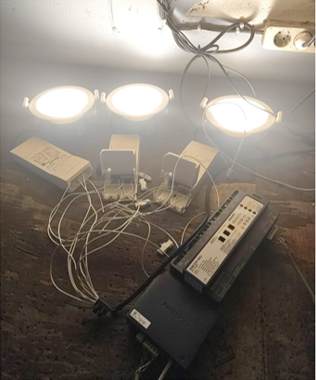Serial Communication Reliability Testing in Dynalite Lighting Control with Adjustable Voltage Levels

Downloads
This research presents the reliability testing of serial communication in Dynalite lighting control systems with adjustable voltage levels. The study began with the design and implementation of a DALI-based topology, followed by practical installation and measurement of output voltages at different control levels (10%, 20%, 40%, 80%, and 100%). The results confirmed that the output voltage correlated proportionally with the configured percentage level, demonstrating stable driver performance in regulating lamp brightness. Furthermore, comparative testing at different baud rates, namely 9600bps and 115200bps, was conducted to evaluate communication stability. The findings revealed that 9600bps provided higher reliability and minimal error, while 115200bps offered faster response but with a higher risk of instability. These results emphasize the importance of selecting appropriate voltage and baud rate configurations to ensure both efficiency and robustness in lighting control systems.
Downloads
[1] H. Ivanov, P. Bekhrad, and E. Leitgeb, “Power Line Communication for Building Automation Using Visible Light Sensing Systems,” in 2022 29th International Conference on Systems, Signals and Image Processing (IWSSIP), June 2022, pp. 1–4. doi: 10.1109/IWSSIP55020.2022.9854440.
[2] D. S. Dawoud and P. Dawoud, Serial Communication Protocols and Standards. New York: River Publishers, 2022. doi: 10.1201/9781003339496.
[3] S. Birkha Mohd Ali, M. Hasanuzzaman, N. A. Rahim, M. A. A. Mamun, and U. H. Obaidellah, “Anal-ysis of energy consumption and potential energy savings of an institutional building in Malaysia,” Alex. Eng. J., vol. 60, no. 1, pp. 805–820, Feb. 2021, doi: 10.1016/j.aej.2020.10.010.
[4] M. Ragnoli, T. De Rubeis, A. Leoni, G. Ferri, and V. Stornelli, “A Low Power Digital Addressable Lighting Interface System for Daylight Control,” in 2024 10th International Conference on Automation, Robotics and Applications (ICARA), Feb. 2024, pp. 397–401. doi: 10.1109/ICARA60736.2024.10553079.
[5] E. Fellew, “Keeping the lights on: Demystifying Dali-2: What is it and how does it differ from Dali?,” Electr. Connect., no. 1, pp. 40–41, Mar. 2025, doi: 10.3316/informit.T2025052200011191643583046.
[6] A. S. J. Wardhana, Zamtinah, T. Sukisno, N. Yuniarti, and M. A. A. Bachrun, “Power Consumption Analysis and Evaluation of Energy Saving Potential of Lighting System in DEF Building,” J. Edukasi Elektro, vol. 9, no. 1, pp. 55–65, May 2025, doi: 10.21831/jee.v9i1.85443.
[7] “Smart LED lighting system with occupants’ preference and daylight harvesting in office buildings: Energy Sources, Part A: Recovery, Utilization, and Environmental Effects: Vol 47, No 1.” Accessed: Aug. 30, 2025. [Online]. Available: https://www.tandfonline.com/doi/abs/10.1080/15567036.2020.1859650
[8] S. Mishra, B. Dhakad, S. S. Ojha, and S. Akashe, “Smart Street Light System Integrated with Internet-of-things based Sensors for Energy Monitoring,” Scalable Comput. Pract. Exp., vol. 26, no. 1, pp. 326–336, Jan. 2025, doi: 10.12694/scpe.v26i1.3542.
[9] P. V. Vinh and P. X. Dung, “Designing a Smart Lighting System for Illuminating Learning Experienc-es,” in From Smart City to Smart Factory for Sustainable Future: Conceptual Framework, Scenarios, and Multidiscipline Perspectives, M. Pagac, J. Hajnys, T. Kozior, H.-S. Nguyen, V. D. Nguyen, and A. Nag, Eds., Cham: Springer Nature Switzerland, 2024, pp. 296–305. doi: 10.1007/978-3-031-65656-9_30.
[10] “Philips Dynalite Dynalite Network Devices,” Philips lighting. Accessed: Aug. 31, 2025. [Online]. Available: https://www.lighting.philips.com/prof/lighting-controls/dynalite/dynalite-network-devices/913703090209_EU/product
[11] G. Parise, G. Zissis, and L. Martirano, “Smart Lighting Systems, Controls, and Communication Proto-cols: Introducing Open Communication Protocols,” IEEE Ind. Appl. Mag., vol. 31, no. 2, pp. 68–79, Mar. 2025, doi: 10.1109/MIAS.2024.3482882.
[12] Z. Xie, C. Yan, X. Ji, and W. Xu, “BitDance: Manipulating UART Serial Communication with IEMI,” in Proceedings of the 26th International Symposium on Research in Attacks, Intrusions and Defenses, in RAID ’23. New York, NY, USA: Association for Computing Machinery, Oct. 2023, pp. 63–76. doi: 10.1145/3607199.3607249.
[13] N. Ekren and B. Sogut, “DALI Compatible Smart LED Driver Controller with Wi-Fi Communication,” Comput. Eng., vol. 11, no. 2, 2023.
[14] J. Choutka, Z. Slanina, I. Pergl, and V. Blazek, “Decentralization of the Lights Control by a DALI Bus with a Connection Node,” in 2023 23rd International Scientific Conference on Electric Power Engineer-ing (EPE), Brno, Czech Republic: IEEE, May 2023, pp. 1–6. doi: 10.1109/EPE58302.2023.10149239.
[15] G. Y. Dayanıklı, A. Z. Mohammed, R. Gerdes, and M. Mina, “Wireless Manipulation of Serial Com-munication,” in Proceedings of the 2022 ACM on Asia Conference on Computer and Communications Security, in ASIA CCS ’22. New York, NY, USA: Association for Computing Machinery, May 2022, pp. 222–236. doi: 10.1145/3488932.3517427.
[16] “Research on network communication modeling technology in digital measurement and control system.” Accessed: Aug. 30, 2025. [Online]. Available: https://www.spiedigitallibrary.org/conference-proceedings-of-spie/13574/135742R/Research-on-network-communication-modeling-technology-in-digital-measurement-and/10.1117/12.3067186.short
[17] W. C. Pu and C. Y. Tsai, “Development of Automatic Digital Control Interface for Addressing a Light-ing Equipment System Using High Power Load,” Sens. Mater., vol. 33, no. 6, p. 1829, June 2021, doi: 10.18494/SAM.2021.3238.
[18] T. Thahir, A. G. K, A. M. Reddy, D. Siddiq, and S. K, “Low-Power Clock-Gated PAM4 SerDes De-sign for High Data Rate Communication System,” in 2025 7th International Conference on Inventive Material Science and Applications (ICIMA), May 2025, pp. 372–378. doi: 10.1109/ICIMA64861.2025.11073935.
[19] F. M. Elamrawy, A. A. El Aziz, S. Khamis, and H. Kasem, “Performance analysis of an indoor visible light communication system using LED configurations and diverse photodetectors,” Sci. Rep., vol. 15, no. 1, p. 16064, May 2025, doi: 10.1038/s41598-025-99643-z.
[20] D. Haripriya, K. Kumar, A. Shrivastava, H. M. R. Al-Khafaji, V. Moyal, and S. K. Singh, “Energy-Efficient UART Design on FPGA Using Dynamic Voltage Scaling for Green Communication in Indus-trial Sector,” Wirel. Commun. Mob. Comput., vol. 2022, no. 1, p. 4336647, 2022, doi: 10.1155/2022/4336647.
[21] J. Bao, X. Song, Y. Li, Y. Bai, and Q. Zhou, “Effect of lighting illuminance and colour temperature on mental workload in an office setting,” Sci. Rep., vol. 11, no. 1, p. 15284, July 2021, doi: 10.1038/s41598-021-94795-0.
[22] C.-W. Liao, H.-C. Yu, and Y.-C. Liao, “Verification of SPI Protocol Using Universal Verification Methodology for Modern IoT and Wearable Devices,” Electronics, vol. 14, no. 5, p. 837, Jan. 2025, doi: 10.3390/electronics14050837.
[23] V. Dankan Gowda, A. Annepu, M. Ramesha, K. Prashantha Kumar, and P. Singh, “IoT Enabled Smart Lighting System for Smart Cities,” J. Phys. Conf. Ser., vol. 2089, no. 1, p. 012037, Nov. 2021, doi: 10.1088/1742-6596/2089/1/012037.
[24] H. Yuksel and Ö. Altunay, “Host-to-host TCP/IP connection over serial ports using visible light com-munication,” Phys. Commun., vol. 43, p. 101222, Dec. 2020, doi: 10.1016/j.phycom.2020.101222.

This work is licensed under a Creative Commons Attribution-ShareAlike 4.0 International License.
The Authors submitting a manuscript do so on the understanding that if accepted for publication, copyright publishing of the article shall be assigned to Journal.



















